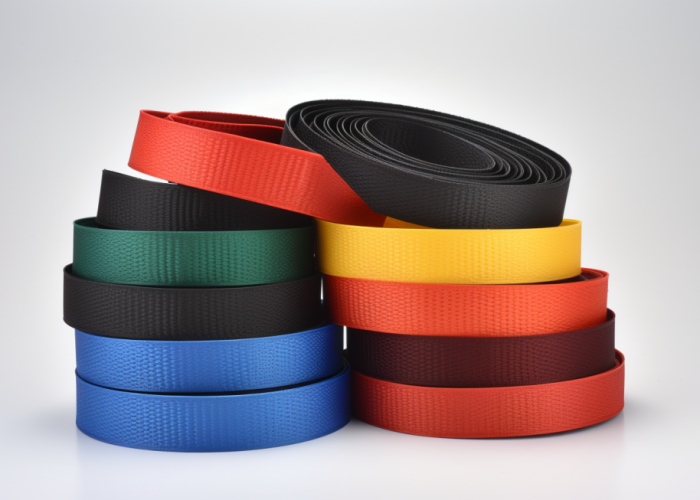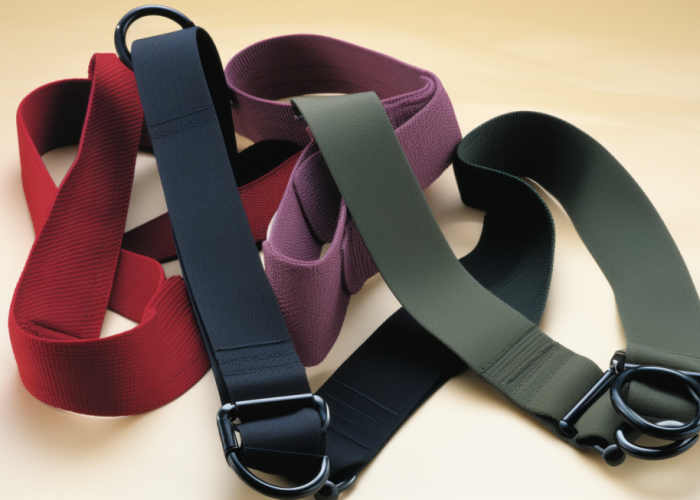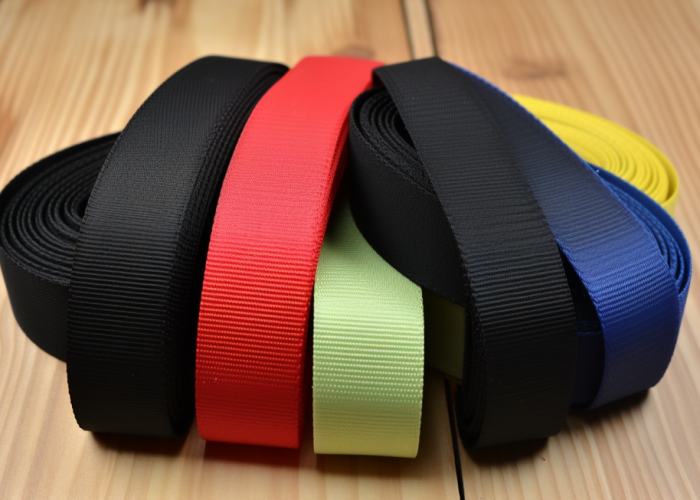Selecting the right webbing for your products demands understanding how materials maintain their dimensions under real-world conditions. With 15+ years testing webbing performance across industries, we’ve determined that dimensional stability directly impacts product durability, precision assembly, and end-user satisfaction.
Dimensional stability in webbing is the ability to maintain original size under heat, moisture, and stress. Heat-set webbing changes less than 0.5%, compared to 3–5% in untreated types, ensuring reliable performance in aerospace, military, and safety applications.
Explore key factors influencing webbing dimensional stability, compare materials, and get expert guidance to select the best webbing for your application—ensuring reliability and avoiding costly redesigns.


Webbing manufacturing expert with 15+ years of experience helping product developers build high-performance straps for industrial, medical, and outdoor use.
Dimensional stability in webbing is the ability of webbing materials to maintain their original dimensions when subjected to various stresses including temperature fluctuations, moisture exposure, mechanical loads, and environmental factors. Poor dimensional stability leads to shrinkage, stretching, warping, or other dimensional changes that directly impact product functionality and reliability.
For product developers and engineers, dimensional stability directly affects several critical aspects of product performance. When webbing components change dimensions unpredictably, they can cause assembly issues, component misalignment, and premature wear. For load-bearing applications, dimensional changes alter the tensile properties and load distribution, potentially leading to product failure.
Industries like aerospace, military, and safety equipment manufacturers specify strict dimensional stability requirements because even minor dimensional changes can compromise product integrity. For instance, aerospace webbing that changes dimensions could alter the fit of critical safety restraints, while military gear with poor dimensional stability might fail prematurely when exposed to varying field conditions.
Different fiber materials exhibit varying levels of dimensional stability with polypropylene generally providing the highest stability (0.1% change), polyester offering moderate stability (0.5-1% change), and nylon showing the most dimensional variation (1-3% change) under similar environmental conditions. The molecular structure and inherent properties of each material determine its response to stress factors.
| Material | Dimensional Stability | Strength | Elongation | Applications |
|---|---|---|---|---|
| Polypropylene | High | Medium | Low | Applications requiring minimal dimensional change |
| Polyester | Medium-High | High | Medium | Balanced strength and stability applications |
| Nylon | Medium | High | High | Applications where some elasticity is beneficial |
Polypropylene webbing shows exceptional dimensional stability due to its semi-crystalline structure and low moisture absorption rate. This makes it ideal for applications where maintaining precise dimensions is crucial, such as medical restraints or precision equipment components. However, it offers less tensile strength than other synthetic fibers.
Polyester webbing provides an excellent balance between dimensional stability and strength. Its molecular structure resists moisture absorption better than nylon, resulting in more consistent dimensions across varying humidity levels. It also demonstrates superior UV resistance, maintaining dimensional integrity even after prolonged outdoor exposure, making it ideal for outdoor equipment and load-bearing applications.
Nylon webbing, while offering outstanding tensile strength and abrasion resistance, exhibits greater dimensional variation, particularly when exposed to moisture. Its hygroscopic nature causes it to absorb up to 4.5% of its weight in water, resulting in more significant dimensional changes. This property makes nylon less suitable for applications requiring precise dimensional tolerances but excellent for applications benefiting from controlled elasticity.
Dimensional stability in webbing is affected by four primary factors: material properties, weaving techniques, heat-setting processes, and environmental conditions. Each factor contributes differently to the overall dimensional stability performance of the finished webbing product.
Material properties serve as the foundation for dimensional stability. Different synthetic fibers exhibit varying degrees of inherent stability based on their molecular structure. Polypropylene shows superior dimensional stability and minimal hygral expansion compared to nylon, which demonstrates greater elasticity and moisture sensitivity. The crystalline structure of the polymer directly influences how the material responds to stress factors.
Weaving techniques significantly impact dimensional stability through their effect on tension distribution and fiber arrangement. Tighter weave construction with higher thread counts per inch creates more stable webbing by reducing the space for individual fibers to shift position. Specialized weaving methods produce webbing with improved dimensional stability by creating more crossover points that help maintain the material’s structure under stress.
Heat-setting processes stabilize the molecular structure of synthetic materials by allowing polymer chains to reorganize into a more stable configuration. Proper heat setting during manufacturing permanently alters the fiber structure, significantly reducing the tendency for dimensional changes when exposed to future stress factors. The temperature range, duration, and cooling rate all influence the effectiveness of the heat-setting process.
Environmental factors represent the external stresses that challenge dimensional stability. Moisture absorption can cause swelling in hygroscopic fibers like nylon, while temperature fluctuations above and below the material’s glass transition temperature can trigger dimensional changes. UV exposure degrades polymer chains over time, progressively altering the material’s dimensional properties and mechanical characteristics.

Heat-setting improves dimensional stability in webbing by reorganizing the molecular structure of synthetic fibers, reducing internal stresses, and creating a more stable crystalline configuration that resists dimensional changes. This thermal process typically occurs between the material’s glass transition temperature and melting point (70-90°C is often optimal) and permanently alters how the webbing responds to environmental stressors.
During heat-setting, the molecular chains in synthetic fibers gain mobility and reorganize into a more thermodynamically stable arrangement. This cross-linked structure significantly reduces the material’s tendency to shrink, stretch, or distort when exposed to future stresses. For polyester webbing, proper heat-setting can improve dimensional stability from 3-5% variation in untreated material to just 0-0.5% in finished products.
The process also minimizes shrinkage and creeping by relieving internal stresses introduced during manufacturing. When synthetic fibers are extruded, woven, and processed, they retain internal stresses that gradually release over time, causing dimensional changes. Heat-setting effectively “pre-releases” these stresses in a controlled environment, resulting in a more dimensionally stable final product.
Heat treatment enhances resistance to environmental factors by stabilizing the crystalline structure of synthetic fibers. This improved structure better withstands temperature fluctuations, moisture exposure, and mechanical stress without significant dimensional changes. For applications exposed to varying environmental conditions, this enhanced stability translates to more consistent performance throughout the product lifecycle.
Manufacturing techniques that improve webbing dimensional stability include specialized weaving methods, precise tension control during production, optimized heat-setting parameters, and comprehensive quality control measures. Each technique addresses specific aspects of dimensional stability at different stages of the manufacturing process.
Specialized weaving methods directly influence how webbing responds to stress factors. Tighter weave construction with more crossover points creates webbing with inherently better dimensional stability by reducing the space for individual fibers to shift position. Advanced looms can create complex weave patterns that distribute tension more evenly across the webbing width, further enhancing dimensional stability under load.
Precise tension control during manufacturing ensures uniform stress distribution throughout the webbing. Inconsistent tension during weaving or heat-setting can create areas with different internal stress levels, leading to uneven dimensional changes when the webbing is used. Modern manufacturing equipment maintains precise tension control throughout the production process, resulting in more consistent dimensional stability.
Optimized heat-setting parameters significantly impact the effectiveness of the molecular restructuring process. The optimal temperature range (typically between 70-90°C), duration, and cooling rate vary depending on the specific material and intended application. Precise control of these parameters ensures maximum molecular reorganization and stress relief without damaging the fibers or compromising other performance characteristics.
Quality control measures throughout the manufacturing process verify dimensional stability performance. Regular testing under controlled environmental conditions helps identify potential issues before products reach customers. Advanced testing equipment can measure dimensional changes with high precision, enabling manufacturers to fine-tune their processes for optimal stability performance.

Environmental exposure affects webbing dimensional stability through moisture absorption, temperature fluctuations, UV radiation damage, and chemical contamination. Different webbing materials respond uniquely to these environmental stressors, with moisture typically causing expansion by 0.5-4.5% and every 20°C temperature increase potentially changing dimensions by 1-3% depending on the material.
Moisture exposure impacts dimensional stability by causing hygroscopic fibers to absorb water and swell. Nylon is particularly susceptible, absorbing up to 4.5% of its weight in water and expanding correspondingly. Polyester absorbs significantly less moisture (around 0.4%) and maintains better dimensional stability in humid environments. Polypropylene shows minimal moisture absorption, making it ideal for applications where consistent dimensions in varying humidity levels are critical.
Temperature fluctuations challenge dimensional stability, especially when crossing the material’s glass transition temperature. Below this temperature, synthetic fibers become more rigid and potentially brittle, while above it, they become more pliable and susceptible to dimensional changes. Repeated temperature cycling accelerates this effect, causing cumulative dimensional changes over time if the material hasn’t been properly heat-set during manufacturing.
UV radiation gradually degrades polymer chains in synthetic fibers, altering their dimensional properties over time. This photodegradation weakens the material structure and can lead to progressive dimensional changes, particularly in outdoor applications with direct sun exposure. Polyester naturally demonstrates better UV resistance than nylon, while specialized additives can enhance UV stability in all synthetic fiber types.
Chemical exposure from cleaning agents, fuels, or industrial processes can compromise dimensional stability by attacking the polymer structure. Different webbing materials show varying chemical resistance, with polypropylene generally offering excellent resistance to acids and bases, while polyester and nylon may be vulnerable to specific chemical compounds that cause swelling, weakening, or degradation of the fiber structure.

Applications and industries requiring high dimensional stability in webbing include aerospace components with tight tolerances (±0.25mm), military equipment subjected to extreme environments, safety-critical restraint systems, precision industrial assemblies, and medical devices where component alignment is crucial. These sectors demand webbing that maintains consistent dimensions despite varying operational conditions.
Aerospace applications specify exceptionally tight dimensional tolerances for webbing components used in aircraft interiors, cargo restraints, and safety equipment. The extreme temperature variations experienced during flight operations (-50°C to +80°C) demand webbing with minimal dimensional response to temperature changes. Heat-set polyester is often preferred for these applications due to its excellent dimensional stability across a wide temperature range.
Military gear requires webbing that maintains consistent dimensions in diverse field conditions. Equipment exposed to desert heat, arctic cold, high humidity, and prolonged UV radiation must function reliably despite these environmental stressors. Load-bearing equipment like tactical vests, harnesses, and equipment carriers rely on dimensionally stable webbing to maintain proper load distribution and prevent equipment shifting during use.
Safety-critical restraint systems depend on dimensional stability to deliver consistent performance during emergency situations. Vehicle safety belts, fall protection equipment, and personal restraints all rely on webbing maintaining precise dimensions to function as designed. Any significant dimensional changes could alter load distribution, engagement with hardware components, or overall restraint geometry.
Precision industrial applications utilize dimensionally stable webbing in conveyor systems, positioning equipment, and specialized machinery components. These applications often involve integrated hardware that requires consistent webbing dimensions for proper alignment and function. Manufacturing processes with high repeatability requirements also benefit from the dimensional predictability that high-stability webbing provides.
Understanding dimensional stability in webbing is essential for product success. By selecting appropriate materials, optimizing manufacturing techniques, and accounting for environmental factors, you’ll ensure your products maintain critical dimensions throughout their lifecycle. Partner with our expert team to develop custom webbing solutions that deliver consistent performance under real-world conditions.
Polyester webbing offers superior dimensional stability with only 0.5-1% dimensional change compared to nylon’s 1-3% variation under similar conditions. This difference stems from polyester’s lower moisture absorption (0.4% vs. nylon’s 4.5%) and more stable molecular structure, making polyester preferable for applications requiring precise dimensional control.
Webbing loses dimensional stability over time primarily due to UV radiation degrading polymer chains, repeated temperature cycling across glass transition points, mechanical stress releasing internal tensions, and moisture absorption-desorption cycles. These factors progressively alter the molecular structure, particularly in materials that weren’t properly heat-set during manufacturing.
Wider webbing typically demonstrates better dimensional stability than narrower webbing of the same material because the increased cross-sectional area distributes stress more evenly and provides more resistance to deformation. Wider webbing also typically features more crossover points in the weave pattern, further enhancing structural integrity and dimensional consistency.
Heat-setting improves dimensional stability in synthetic webbing by 80-90%, reducing variation from 3-5% in untreated materials to just 0-0.5% in properly heat-set webbing. This improvement comes from reorganizing the molecular structure, relieving internal stresses, and creating a more stable crystalline configuration that resists environmental and mechanical stressors.
Polypropylene webbing maintains the best dimensional stability in high-moisture environments with nearly zero moisture absorption and dimensional change under humid conditions. Polyester ranks second with minimal absorption (0.4%) and good stability, while nylon performs worst, absorbing up to 4.5% moisture and experiencing corresponding dimensional changes.
Yes, dimensionally stable webbing can provide controlled elasticity through specific weave patterns, material selection, and manufacturing techniques. Heat-set polyester and nylon can deliver predictable, consistent elasticity while resisting permanent deformation, making them ideal for applications requiring both reliable elasticity and dimensional recovery.